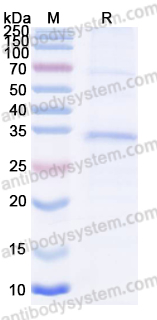Catalog No.
YHK09301
Expression system
E. coli
Species
Homo sapiens (Human)
Protein length
Met1-Thr252
Predicted molecular weight
29.65 kDa
Nature
Recombinant
Endotoxin level
Please contact with the lab for this information.
Purity
>90% as determined by SDS-PAGE.
Accession
Q92915
Applications
ELISA, Immunogen, SDS-PAGE, WB, Bioactivity testing in progress
Form
Lyophilized
Storage buffer
Lyophilized from a solution in PBS pH 7.4, 0.02% NLS, 1mM EDTA, 4% Trehalose, 1% Mannitol.
Reconstitution
Reconstitute in sterile water for a stock solution.
Shipping
In general, proteins are provided as lyophilized powder/frozen liquid. They are shipped out with dry ice/blue ice unless customers require otherwise.
Stability and Storage
Use a manual defrost freezer and avoid repeated freeze thaw cycles. Store at 2 to 8°C for frequent use. Store at -20 to -80°C for twelve months from the date of receipt.
Alternative Names
Fibroblast growth factor 14, FGF-14, Fibroblast growth factor homologous factor 4, FHF-4, FGF14, FHF4
Increased expression of FGF14 and SCN2A/SCN11A is associated with better survival of HCC patients., PMID:40329566
Loss of intracellular FGF14 (iFGF14) increases excitability of mature hippocampal pyramidal neurons., PMID:40323232
Deletion of Fgf14 confers resilience to basal and stress-induced depressive-like behavior and reduces anxiety in mice., PMID:40204701
Novel In-Frame FGF14 Deletion Causes Spinocerebellar Ataxia Type 27A: Clinical Response to Deep Brain Stimulation and 4-Aminopyridine., PMID:40156335
Production and purification of recombinant long protein isoforms of FGF11 subfamily., PMID:40154621
Identifcation of the FGF family as therapeutic targets and prognostic biomarkers in the microenvironment of head and neck squamous cell carcinoma., PMID:40086631
Late-onset vestibulocerebellar ataxia: clinical and genetic studies in a long follow-up series of 50 patients., PMID:40024931
Exosomes in Regulating miRNAs for Biomarkers of Neurodegenerative Disorders., PMID:39918711
Delayed Progression of Ataxia with a Static Cerebellar Lesion- Consider SCA27B., PMID:39821862
Developmental changes of skin quality from breast, back, and thigh of Pekin ducks from 1 to 6 weeks of age., PMID:39817987
Enhanced motivated behavior mediated by pharmacological targeting of the FGF14/Nav1.6 complex in nucleus accumbens neurons., PMID:39747162
The First Case of Autosomal Recessive Cerebellar Ataxia with Prominent Paroxysmal Non-kinesigenic Dyskinesia Caused by a Truncating FGF14 Variant in a Turkish Patient., PMID:39704271
How to distinguish spinocerebellar ataxia 27B from late onset cerebellar ataxia: insights from a case-control study., PMID:39666053
Frequency of FGF14 intronic GAA repeat expansion in patients with multiple system atrophy and undiagnosed ataxia in the Japanese population., PMID:39604554
Molecular Signatures of Resilience to Alzheimer's Disease in Neocortical Layer 4 Neurons., PMID:39574639
Screening for SCA27B, CANVAS and other repeat expansion disorders in Greek patients with late-onset cerebellar ataxia suggests a need to update current diagnostic algorithms., PMID:39571249
In Vivo Expression of an SCA27A-linked FGF14 Mutation Results in Haploinsufficiency and Impaired Firing of Cerebellar Purkinje Neurons., PMID:39484407
Somatic instability of the FGF14-SCA27B GAA•TTC repeat reveals a marked expansion bias in the cerebellum., PMID:39378335
Clinical, Radiological and Pathological Features of a Large American Cohort of Spinocerebellar Ataxia (SCA27B)., PMID:39263992
Identification and characterisation of pathogenic and non-pathogenic FGF14 repeat expansions., PMID:39227614
The episodic ataxias., PMID:39174244
Genetic profiles of multiple system atrophy revealed by exome sequencing, long-read sequencing and spinocerebellar ataxia repeat expansion analysis., PMID:39152783
Introducing effective genes in lymph node metastasis of breast cancer patients using SHAP values based on the mRNA expression data., PMID:39150915
Crosstalk among WEE1 Kinase, AKT, and GSK3 in Nav1.2 Channelosome Regulation., PMID:39125637
Low prevalence of SCA27B in adult-onset cerebellar ataxia cohort of Jewish ancestry., PMID:39003951
Spinocerebellar ataxia type 27B (SCA27B) in India: insights from a large cohort study suggest ancient origin., PMID:38976084
A common flanking variant is associated with enhanced stability of the FGF14-SCA27B repeat locus., PMID:38937606
Spinocerebellar ataxia 27B: a frequent and slowly progressive autosomal-dominant cerebellar ataxia-experience from an Italian cohort., PMID:38886208
Characteristics of tandem repeat inheritance and sympathetic nerve involvement in GAA-FGF14 ataxia., PMID:38866925
Complete nanopore repeat sequencing of SCA27B (GAA-FGF14 ataxia) in Japanese., PMID:38816190
Spinocerebellar ataxia 27B (SCA27B), a frequent late-onset cerebellar ataxia., PMID:38609751
GAA-FGF14 disease: defining its frequency, molecular basis, and 4-aminopyridine response in a large downbeat nystagmus cohort., PMID:38507876
RFC1 and FGF14 Repeat Expansions in Serbian Patients with Cerebellar Ataxia., PMID:38487929
FGF14 GAA repeat expansion and ZFHX3 GGC repeat expansion in clinically diagnosed multiple system atrophy patients., PMID:38472396
RFC1 repeat expansions in downbeat nystagmus syndromes: frequency and phenotypic profile., PMID:38381176
The FGF14 gene is a milestone in ataxia genetics., PMID:38301484
TNFR1 signaling converging on FGF14 controls neuronal hyperactivity and sickness behavior in experimental cerebral malaria., PMID:38115011
Clinical variability associated with intronic FGF14 GAA repeat expansion in Japan., PMID:37916889
Genomic selection pressure discovery using site-frequency spectrum and reduced local variability statistics in Pakistani Dera-Din-Panah goat., PMID:37750990
Reply to: "Non-GAA Repeat Expansions in FGF-14 Are Likely Not Pathogenic"., PMID:37565403
Autosomal dominant cerebellar ataxias: new genes and progress towards treatments., PMID:37479376
Natural History and Phenotypic Spectrum of GAA-FGF14 Sporadic Late-Onset Cerebellar Ataxia (SCA27B)., PMID:37470282
Sex-Specific Genetic Determinants of Asthma-COPD Phenotype and COPD in Middle-Aged and Older Canadian Adults: An Analysis of CLSA Data., PMID:37466093
Pearls & Oy-sters: ATX-FGF14 Mimicking Autoimmune Pathology., PMID:37460234
FGF homologous factors are secreted from cells to induce FGFR-mediated anti-apoptotic response., PMID:37342898
Shaking Up Ataxia: FGF14 and RFC1 Repeat Expansions in Affected and Unaffected Members of a Chilean Family., PMID:37246629
Deep intronic FGF14 GAA-repeat expansion in late-onset cerebellar ataxia: Last but not least., PMID:36906458
Identification and gene expression profiling of human gonadotrophic pituitary adenoma stem cells., PMID:36750863
Genome-wide Association Study of Methotrexate-Induced Liver Injury in Rheumatoid Arthritis Patients., PMID:36708065


